Are you looking for a unique wildlife experience? If so, head to West Virginia and discover the amazing world of brown spiders! Spiders may not be the most popular critters, but once you get to know these creepy crawlers, you’ll find that they are incredibly fascinating and do a lot for our environment.
In this article, we’ll take a closer look at some well-known and lesser-known brown spiders in West Virginia. We’ll learn about their appearance, diet, habitat, behavior, and other cool arachnid facts!
1. Common House Spider (Parasteatoda tepidariorum)

©Sample Stars/Shutterstock.com
The common house spider bears this name for a reason. It is among the most commonly encountered spiders in households across West Virginia. These tiny, mottled brown spiders are easily recognized by their dark-brown coloration and stripes running along its sides. They measure between 0.15 and 0.24 inches in length, with females typically larger than males.
These spiders are versatile species that can inhabit many environments and dwellings, including attics, basements, garages, sheds, walls, and ceilings. You’ve probably encountered these spiders quite regularly in your own home. Common house spiders feed on insects such as flies, mosquitoes, moths, and beetles. These spiders typically build small, messy webs in corners and other protected areas. They are non-aggressive and rarely bite humans, so don’t worry if you find one chilling in the corner of your house! In fact, these spiders help rid your home of insects.
Fun Fact About the Common House Spider
The common house spider has special glands that produce a very sticky and robust web, allowing it to stay attached to its web even when disturbed.
2. Jumping Spider (Phidippus audax)
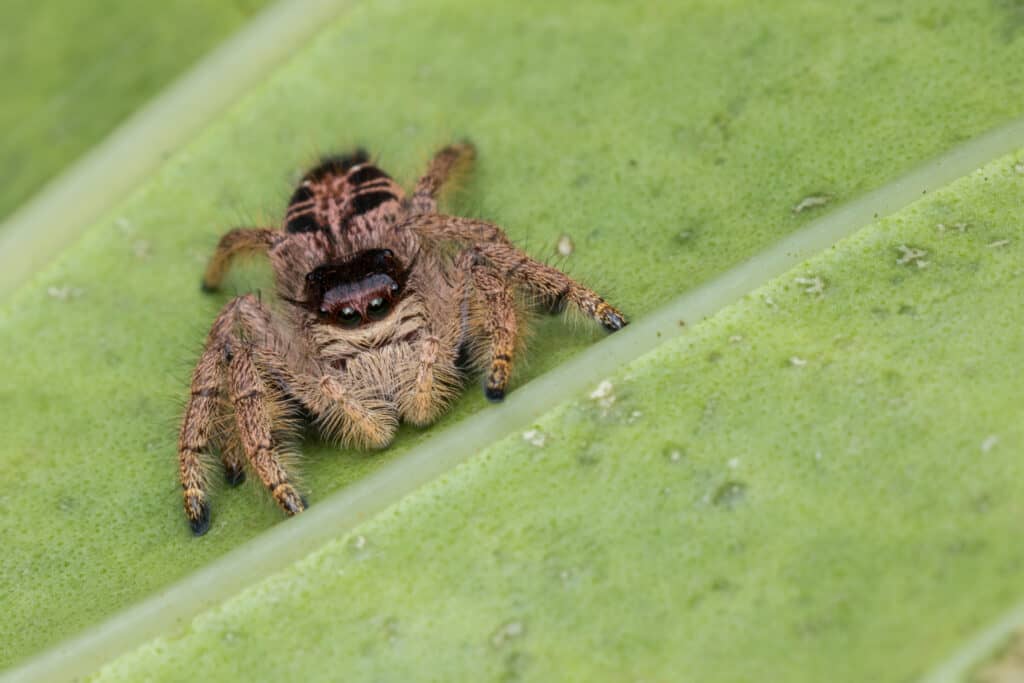
©iStock.com/Thien Woei Jiing
The jumping spider is a tiny, active brown spider found across West Virginia and the United States. These spiders have a unique appearance, with their large eyes and metallic-looking coloration. They have four pairs of eyes on the front of the head and two large black eyes pointing upwards in the back! But you generally won’t be able to see this spider to this detail as they’re quite small at only 1/8 to 3/4 inches long.
Jumping spiders are carnivores, preying primarily on small invertebrates such as aphids, flies, beetles, and caterpillars. They can jump up to 50 times their body length (hence their name), making them agile hunters. To aid in catching prey, this spider has two claws on each of its eight legs to grasp and climb surfaces.
These spiders often make their homes in trees, under rocks and logs, or even inside the cracks and crevices of buildings.
During the day, they hang out in one spot for extended periods, usually near a web or other protected area. At night, however, jumping spiders become far more active and can be seen wandering around looking for prey.
Jumping spiders are harmless to humans and display exciting behaviors. For instance, when threatened, they often raise their front legs and wave them around as a warning sign. When hunting prey, they move slowly towards it while waving their front legs around to help detect any movement.
Fun Fact About the Jumping Spider
The jumping spider can distinguish colors and recognize specific patterns, one of the few species of spiders with this ability.
3. Wolf Spider (Lycosidae)
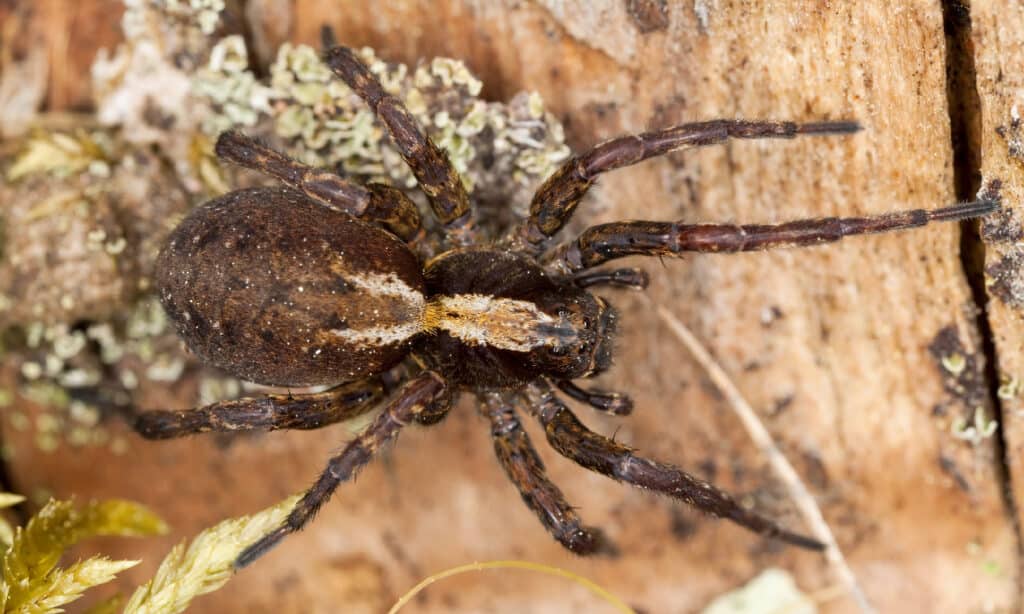
©iStock.com/Henrik_L
The wolf spider, also known as Lycosidae, is a species that scurries around with speed and agility. It has a distinct color pattern of black, yellow, gray, brown, and sometimes white. Wolf spiders have eight eyes in three rows: two large ones at the top of their head, with two larger ones across the middle row, and four more on the bottom row. They have hairy bodies, and their legs are usually gray or brown, with paler stripes running along them.
Wolf spiders hunt alone and can be found in almost any habitat – grasslands, forests, deserts, and even inside homes. They hide during the day and hunt at night, using their eyes to detect movement. They feed mainly on insects, but some larger species can also eat small lizards or frogs.
Although they may look intimidating, wolf spiders are not very aggressive and will usually run away if threatened. When disturbed, they may rear up on their hind legs and wave their front legs in the air – a behavior known as “tripod dancing”! They are also good mothers, carrying their eggs in a sac attached to their abdomen until they hatch.
Fun Fact About the Wolf Spider
Wolf spiders have four sets of eyes, giving them a 360° view of their surroundings! This is one factor that helps them detect prey easily.
4. Cellar Spider (Pholcidae)

©Vinicius R. Souza/Shutterstock.com
The cellar spider, or Pholcidae, is a common arachnid found in West Virginia. This brown spider has a long and slender body mostly covered in short hairs, and its legs can stretch up to 2 inches long. It also has a unique, almost peanut-shaped body. This spider has six to eight eyes spread out in three different pairs, with two pairs located on the top of its head.
The diet of the cellar spider is mainly comprised of small insects and other spiders. They often create webs to catch their prey. Cellar spiders can usually be found in places like cellars (of course!), basements, and wall crevices.
The behavior of the cellar spider is characterized by aggressive defense when its web is disturbed. When threatened, it will vibrate rapidly to deter the intruder. It may also bite if provoked.
Fun Fact About the Cellar Spider
The webs created by the cellar spider are often called “messy webs” due to their chaotic and tangled nature. These webs are effective at catching prey, even if they don’t look aesthetically pleasing.
5. Trapdoor Spider (Ummidia)
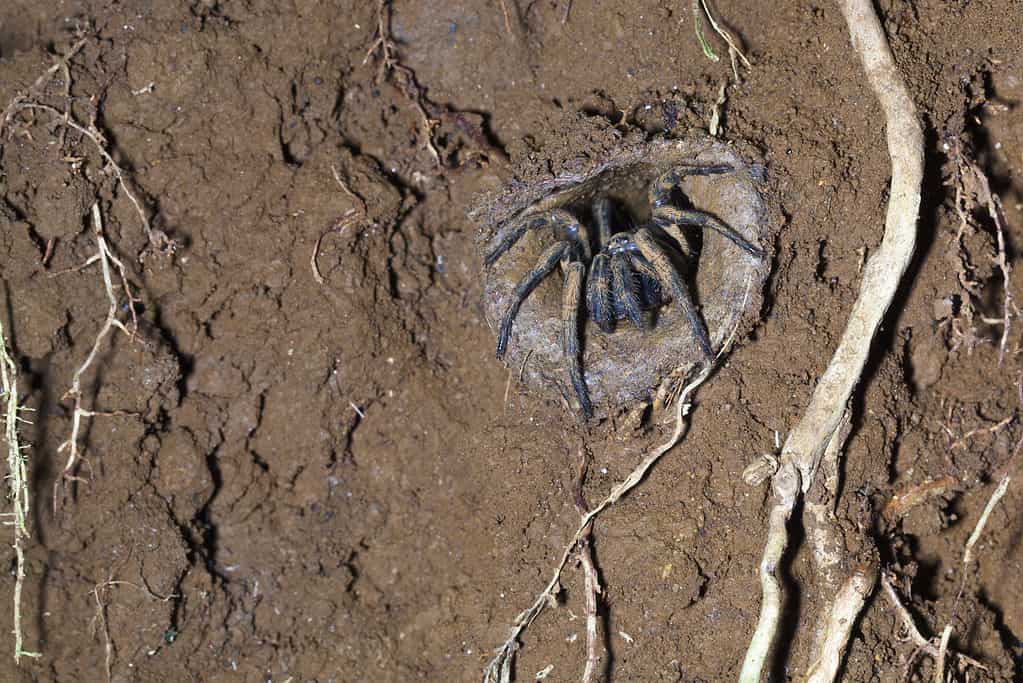
©iStock.com/zstockphotos
When looking for brown spiders in West Virginia, it’s impossible to miss the trapdoor spider. This species has a distinct coloration of yellowish-brown with dark stripes running along its body and legs. It can grow up to 1.6 inches in length and is usually found near wooded areas or inside homes.
Trapdoor spiders have a giant, hard exoskeleton and powerful jaws, which they use to catch prey like small animals and beetles. The trapdoor spider does not spin webs but instead builds a “trapdoor” out of soil and leaves, which it hides behind before ambushing its prey.
Trapdoor spiders are solitary creatures that prefer to live in isolation. They may run away or close their “doors” to protect themselves when disturbed. However, if provoked or cornered, they can become aggressive and bite.
Fun Fact About the Trapdoor Spider
The trapdoor spider is nocturnal, meaning it hunts and builds its trapdoors at night when it’s less likely to be disturbed!
6. Furrow Spider (Larinioides cornutus)
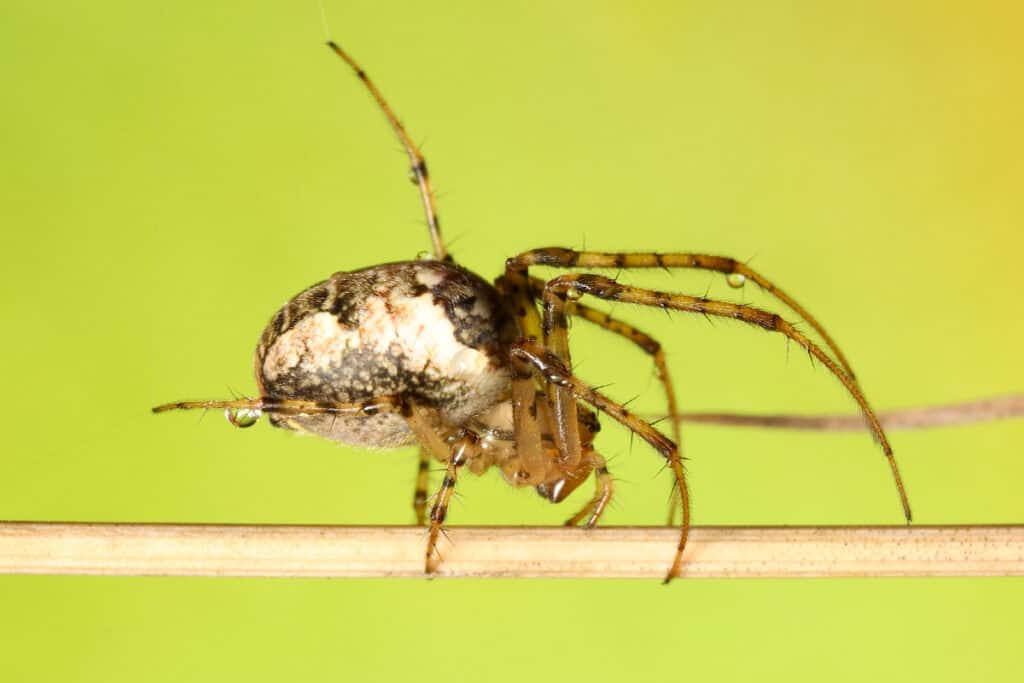
©iStock.com/Dan Olsen
The furrow spider is a member of the Araneidae family. It has a flat, long body that can reach up to ½ inch in length. While mostly brown, this spider also has an interesting-looking pattern resembling an arrow on the abdomen, usually in gray and white. Its legs are also brown with black stripes.
This spider species is a hunter, and it preys on insects like flies. It spins its web with the help of the adhesive silk from its spinnerets. It then waits for an insect to get stuck in the web and comes out to catch it You can usually find it in moist places like under stones, logs, and even in the corners of your house. When disturbed or cornered, it may quickly run from one place to another.
Fun Fact About the Furrow Spider
Furrow spiders have oval abdomens capable of storing air for long periods, allowing them to survive underwater. This is why you might often find them near water sources or damp areas.
7. Woodlouse Spider (Dysdera crocata)

©Macronatura.es/Shutterstock.com
The woodlouse spider is a medium-sized spider, measuring around 0.3 to 0.5 inches in length, with females slightly larger than males. It has a light brown body, dark-red or orange head, and six eyes in three rows (two larger eyes and four smaller eyes). They also feature short legs and a wide, flattened body.
These spiders are common in West Virginia, typically found hiding under rocks, logs, and other debris throughout the state’s woodlands and fields.
The woodlouse spider feeds on woodlice (also known as sowbugs) and other small invertebrates living in these same habitats. They can often be seen hunting in dark, damp areas or around wood piles during the day.
Woodlouse spiders are non-aggressive and do not pose any threat to humans. They can bite if provoked, but the venom is usually mild and causes little more than a slight stinging sensation.
Fun Fact About the Woodlouse Spider
This spider is one of the few species that roll into a ball as a defense mechanism. They curl up their legs and hide their face in the center for protection, a behavior known as “balling up.”
8. American Nursery Web Spider (Pisaurina mira)
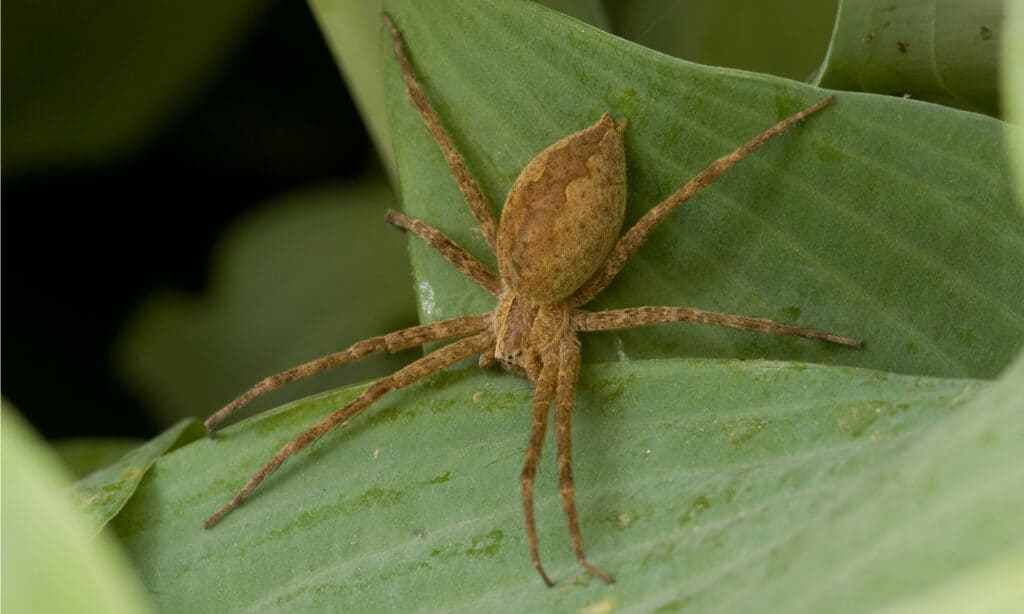
©SDeming/Shutterstock.com
The American nursery web spider is large, brown, and found in wooded areas and gardens throughout West Virginia. They can reach up to 3/4 inches in length and have a distinctive dark stripe running down the middle of their abdomen. They spin large, open webs that span up to two feet wide!
Their primary diet consists of grasshoppers, crickets, and butterflies, but they also feed on small rodents, frogs, and lizards. American nursery web spiders are active hunters and fierce predators.
Though they can be aggressive when disturbed, these spiders are generally harmless to humans. They’re also beneficial for keeping pest populations in check, so if you find one in your garden or yard, don’t hesitate to let them stay!
Interestingly, female spiders sometimes make a “nursery web,” where she keeps the egg-sacs and young until they hatch. Usually, these webs are built in a tree or bush, and the female stays nearby to protect her young from predators.
Fun Fact About the American Nursery Web Spider
American nursery web spiders can often be seen sunbathing on the edges of their webs, warming up and drying off after a night of hunting. So, if you’re out looking for spiders, check in sunny spots!
Conclusion
West Virginia is home to various brown spiders of different sizes, behaviors, and diets. From the furrow spider’s ability to survive underwater to the American nursery web spiders’ protective “nursery webs,” these arachnids are fascinating creatures.
Look closely beneath rocks, in crevices, or under leaf piles, and you might just find a brown spider!
The post Discover 8 Brown Spiders in West Virginia appeared first on AZ Animals.
from Animal News, Facts, Rankings, and More! - AZ Animals https://ift.tt/pW3a8lb